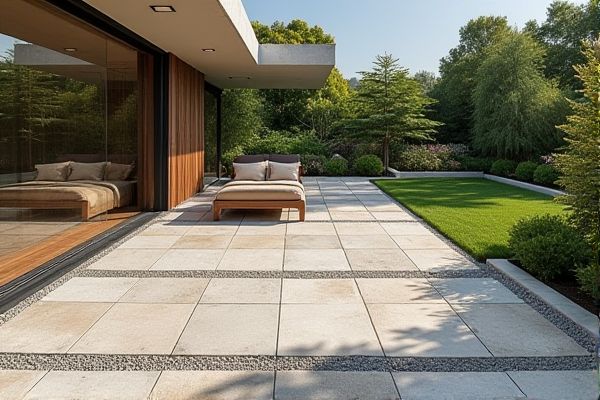
Gravel flooring offers a natural, porous surface ideal for drainage and low maintenance, while deck tiles provide a more polished, customizable look that enhances comfort and style on your terrace. Explore the article to discover which option best suits your outdoor space and lifestyle preferences.
Table of Comparison
| Feature | Gravel Flooring | Deck Tiles (Terrace) |
|---|---|---|
| Material | Natural stones, small rocks | Wood, composite, plastic, rubber |
| Installation | Simple, requires ground preparation | Interlocking or snap-on tiles, moderate effort |
| Durability | Long-lasting, weather-resistant | Varies by material; composite highly durable |
| Maintenance | Low; occasional raking and topping-up | Medium; cleaning and replacing damaged tiles |
| Comfort & Safety | Uneven surface, risk of slipping | Stable surface, slip-resistant options available |
| Drainage | Excellent natural drainage | Depends on design; some drainage limitations |
| Aesthetic Appeal | Natural, rustic look | Modern, customizable appearance |
| Cost | Low to moderate | Moderate to high, depending on material |
| Ideal Usage | Garden paths, casual terraces | Balconies, rooftop terraces, patios |
Introduction: Gravel Flooring vs Deck Tiles for Terraces
Gravel flooring offers a cost-effective, permeable surface that enhances drainage and provides a natural aesthetic for terraces, while deck tiles deliver a sleek, customizable look with easy installation and maintenance. Your choice depends on factors such as style preference, durability, and specific terrace usage, as gravel excels in rustic charm and water management, whereas deck tiles provide comfort and a polished finish. Consider the climate, foot traffic, and long-term upkeep when deciding between gravel flooring and deck tiles for your outdoor terrace.
Aesthetic Appeal: Visual Differences
Gravel flooring offers a natural, rustic aesthetic with earthy tones and irregular textures that blend seamlessly into garden or outdoor terrace settings. Deck tiles provide a more polished, uniform appearance with customizable patterns and finishes, enhancing the modern or sophisticated look of your terrace. Your choice depends on whether you prefer organic charm or sleek, structured visuals for your outdoor space.
Installation Process: Effort and Time Needed
Gravel flooring requires minimal preparation, involving leveling the ground and installing a weed barrier before spreading the gravel, making it a quick and low-effort option. Deck tiles necessitate a clean, flat surface and precise placement, often requiring interlocking tiles to be carefully aligned, which can be more time-consuming and labor-intensive. While gravel installation can be completed in a few hours, deck tiles typically take longer due to the need for accurate fitting and securing each tile in place.
Durability and Longevity Comparison
Gravel flooring offers excellent drainage and low maintenance but can shift or scatter over time, requiring occasional replenishment to maintain its appearance and functionality. Deck tiles, typically made from weather-resistant materials like composite wood or stone, provide a sturdy surface with greater long-term durability and an easy-to-replace modular design. Choosing between gravel and deck tiles depends on your terrace usage and desired lifespan, with deck tiles generally offering superior longevity and structural stability.
Maintenance Requirements and Costs
Gravel flooring demands less upfront investment but requires regular raking and weed control to maintain an even surface and prevent overgrowth, leading to moderate ongoing costs. Deck tiles, made from wood, composite, or stone, involve higher initial installation expenses but benefit from simpler maintenance such as occasional cleaning and sealing, resulting in lower long-term upkeep. Choosing between gravel and deck tiles for your terrace depends on balancing your budget constraints against your willingness to perform consistent maintenance tasks.
Comfort and Practicality Underfoot
Gravel flooring offers a natural, breathable surface that provides good drainage but may feel uneven and less comfortable underfoot for extended periods. Deck tiles, typically made from wood, composite, or stone, deliver a smoother, more stable surface that enhances comfort and ease of movement on your terrace. For practical maintenance, deck tiles are easier to clean and rearrange, while gravel requires occasional raking and replenishment to maintain an even layer.
Drainage and Water Management Performance
Gravel flooring excels in drainage and water management due to its porous nature, allowing rainwater to pass through easily and reducing runoff. Deck tiles, often made of wood, composite, or plastic, typically require built-in drainage systems or gaps between tiles to prevent water pooling and ensure proper drainage. In terrace applications, gravel provides a low-maintenance, naturally permeable surface, while deck tiles offer a more structured finish but depend heavily on design and installation quality for effective water management.
Eco-Friendliness and Sustainability
Gravel flooring offers an eco-friendly option by allowing natural water drainage and reducing heat retention, contributing to sustainable landscaping practices. Deck tiles, often made from recycled wood or composite materials, provide durable surfaces while minimizing deforestation and promoting reuse of resources. Both options support green building principles, but gravel flooring typically has a lower environmental impact due to its minimal processing and natural composition.
Cost Analysis: Initial and Long-Term Expenses
Gravel flooring offers a low initial cost, typically ranging from $1 to $3 per square foot, with minimal long-term maintenance expenses due to its durability and natural drainage properties. Deck tiles, priced between $5 and $15 per square foot, require a higher upfront investment and periodic upkeep such as cleaning and resealing to maintain appearance and prevent damage. Over time, gravel proves more cost-effective for budget-conscious homeowners, while deck tiles provide aesthetic value that may justify the higher ongoing costs.
Best Use Cases: Choosing the Right Option for Your Terrace
Gravel flooring offers excellent drainage and a natural, rustic look ideal for garden terraces or areas requiring easy maintenance and flexibility. Deck tiles provide a polished, uniform surface perfect for creating stylish, comfortable outdoor living spaces with quick installation and customization options. Your choice depends on whether you prioritize durability and a refined appearance with deck tiles or cost-effectiveness and organic charm with gravel flooring.
 homyna.com
homyna.com